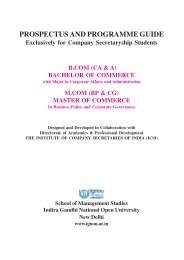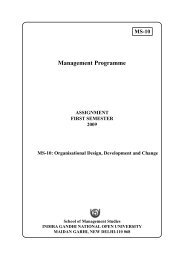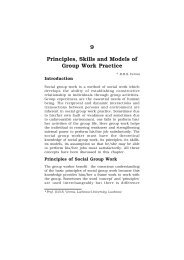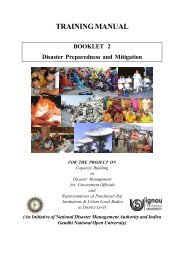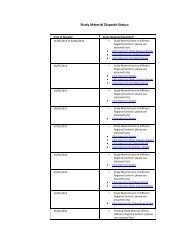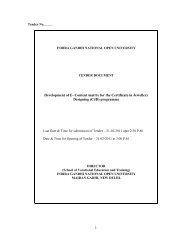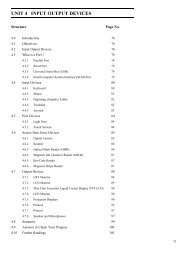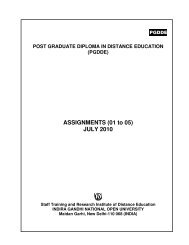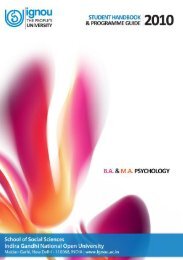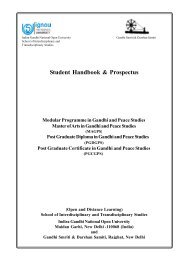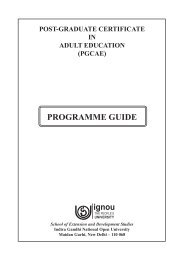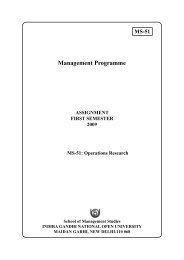Disaster Recovery and the Road Ahead - IGNOU
Disaster Recovery and the Road Ahead - IGNOU
Disaster Recovery and the Road Ahead - IGNOU
Create successful ePaper yourself
Turn your PDF publications into a flip-book with our unique Google optimized e-Paper software.
Administrative Training Institutes. The<br />
Central Board of Secondary<br />
Education (CBSE) in New Delhi has<br />
introduced disaster management as<br />
a separate subject in st<strong>and</strong>ards VIII<br />
<strong>and</strong> IX in schools. The National<br />
Council for Educational Research<br />
<strong>and</strong> Training (NCERT) books now<br />
include lessons on disaster<br />
management for school children.<br />
xi)<br />
xii)<br />
On <strong>the</strong> pattern of India <strong>Disaster</strong><br />
Resource Network (IDRN) in <strong>the</strong><br />
Source: NDMA Photo Gallery<br />
Government domain, a Corporate<br />
<strong>Disaster</strong> Resource Network (CDRN) has been planned to be built up in <strong>the</strong> public domain. It<br />
would be an information platform where details of all such products would be available, which<br />
are required in emergency response of various types. This would greatly help in <strong>the</strong> procurement<br />
of items required in times of need <strong>and</strong> would help in showcasing <strong>the</strong> products of <strong>the</strong> corporate<br />
sector. It would also help <strong>the</strong> corporate world in knowing what is required when <strong>and</strong> where,<br />
<strong>and</strong> accordingly as a part of Corporate Social Responsibility donate such products.<br />
While <strong>the</strong> NDRF is being trained, re-trained <strong>and</strong> equipped as a specialist force for highly<br />
devastating disasters, it is equally important to ensure capacity building of state police personnel<br />
who are <strong>the</strong> first responders in any natural or man-made disasters. To ensure this, a twopronged<br />
strategy is being suggested to <strong>the</strong> states: firstly, to train state police personnel in <strong>the</strong><br />
basics of disaster management <strong>and</strong> secondly, to train at least one equivalent battalion out of <strong>the</strong>ir<br />
state armed police units as State <strong>Disaster</strong><br />
Response Force (SDRF) on lines of <strong>the</strong><br />
NDRF. In addition to police personnel,<br />
<strong>the</strong> SDRFs may be constituted from<br />
existing resources of <strong>the</strong> Fire Services,<br />
Home Guards <strong>and</strong> Civil Defence. NDRF<br />
Battalions <strong>and</strong> <strong>the</strong>ir training institutions will<br />
assist <strong>the</strong> States/UTs in this effort. The<br />
State/ UTs will also be encouraged to set<br />
up DM training facilities in <strong>the</strong>ir respective<br />
Police Training Colleges, <strong>and</strong> include <strong>the</strong><br />
subject in <strong>the</strong>ir basic <strong>and</strong> in-service<br />
courses.<br />
xiii) NDMA has taken <strong>the</strong> following initiatives<br />
for disaster resilience:<br />
Source: Tsunami 2004/Google Images<br />
(a)<br />
(b)<br />
(c)<br />
Policy, Plans <strong>and</strong> Guidelines<br />
Mainstreaming <strong>and</strong> Mitigation Projects<br />
Scientific <strong>and</strong> Technological Initiatives<br />
74



